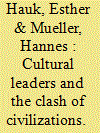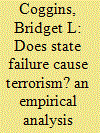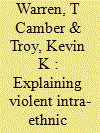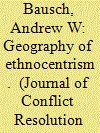|
|
|
Sort Order |
|
|
|
Items / Page
|
|
|
|
|
|
|
| Srl | Item |
| 1 |
ID:
138079


|
|
|
|
|
| Summary/Abstract |
This article investigates whether attacks against Israeli targets help Palestinian factions gain public support. We link individual-level survey data to the full list of Israeli and Palestinian fatalities during the period of the Second Intifada (2000– 2005) and estimate a flexible discrete choice model for faction supported. We find some support for the ‘‘outbidding’’ hypothesis, the notion that Palestinian factions use violence to gain prestige and influence public opinion within the community. In particular, the two leading Palestinian factions, Hamas and Fatah, gain in popularity following successful attacks against Israeli targets. Our results suggest, however, that most movement occurs within either the secular groups or the Islamist groups, but not between them. That is, Fatah’s gains come at the expense of smaller secular factions, while Hamas’s gains come at the expense of smaller Islamic factions and the disaffected. In contrast, attacks by the Palestinian Islamic Jihad lower support for that faction.
|
|
|
|
|
|
|
|
|
|
|
|
|
|
|
|
| 2 |
ID:
138073


|
|
|
|
|
| Summary/Abstract |
This article builds a microfounded model of cultural conflict. In this model, intrinsically motivated cultural leaders supply and interpret culture. Leaders have an incentive to amplify disagreement about cultural values. This leads to a clash of perspectives between cultures. The population benefits from the supply of culture but suffers if leaders amplify the clash of perspectives. The article discusses constraints to leader behavior and analyzes how economic factors affect the incentives of cultural leaders. Economic strength can lead to displays of cultural arrogance while economic integration between groups can hinder cultural alienation.
|
|
|
|
|
|
|
|
|
|
|
|
|
|
|
|
| 3 |
ID:
138075


|
|
|
|
|
| Summary/Abstract |
Does military intervention affect civilian death tolls? Existing research has focused on international actors’ ability to limit ongoing slaughter but has not examined their ability to prevent the emergence or escalation of such killing. I develop a theory of government killing that accounts not only for the government’s decision to kill civilians but also for the transference of the killing order from leader to perpetrator, and for the perpetrator’s implementation of that order. Focusing on the principal– agent relationship produces new expectations about the effects of military intervention on government killing. I find that international actors are well equipped to limit civilian slaughter: intervention supporting the government decreases the likelihood that a government orders civilians killed. Intervention against the government leads to a decrease in death tolls when killing occurs. Ultimately, supportive intervention is a useful means of preventing government killing, while oppositional intervention limits its escalation once it begins.
|
|
|
|
|
|
|
|
|
|
|
|
|
|
|
|
| 4 |
ID:
138076


|
|
|
|
|
| Summary/Abstract |
A developed-world consensus ties state failure to new and serious international insecurity. But that conclusion rests upon an uncertain foundation; insights into the nature and intensity of failure-related threats remain tentative and unsystematic. This study begins to remedy the problem, examining the broad relationships between weakness, failure, and terrorism with panel data for 153 countries (1999–2008). I argue that the quantitative literature too often disregards the political context determining terrorism’s use, that terrorism is endogenous to many measures of state failure, and that estimates of the failure-related threat of terrorism are overstated. Consistent with these expectations, I find that most failing and failed states are not predisposed to terrorism. However, among the ‘‘most failed’’ states, those at war or experiencing political collapse are significantly more likely to experience and produce terror. These results refine the relationship between failure and external threat and highlight the importance of terrorism’s macro-level political context.
|
|
|
|
|
|
|
|
|
|
|
|
|
|
|
|
| 5 |
ID:
138077


|
|
|
|
|
| Summary/Abstract |
Despite significant advances in the disaggregation of the study of civil conflict and intraethnic violence, intra-ethnic violence remains understudied. In this article, we present the first systematic, cross-national analysis of the conditions that promote violent, fragmentary conflict within politically active ethnic minorities. We propose a model of intra-ethnic conflict in which collective violence is produced by the interaction between subgroup entrepreneurs and the suppressive actions of the state. This two-level model predicts a curvilinear relationship between the relative size of an ethnic minority and its probability of experiencing large-scale intra-ethnic conflict. Additional hypotheses based on the proposed causal mechanism are also posited. These hypotheses are tested with data drawn from a global sample of politically active ethnic minorities, for the period 1990 through 2006, using a combination of parametric and semi-parametric regression techniques. The results strongly confirm the predicted curvilinear relationship while also demonstrating that the specific shape of this relationship shifts in predictable ways under varying social and political contexts.
|
|
|
|
|
|
|
|
|
|
|
|
|
|
|
|
| 6 |
ID:
138078


|
|
|
|
|
| Summary/Abstract |
Hammond and Axelrod use an evolutionary agent-based model to explore the development of ethnocentrism. They argue that local interactions permit groups, relying on in-group favoritism, to overcome the Nash equilibrium of the prisoner’s dilemma and sustain in-group cooperation. This article shows that higher levels of cooperation evolve when groups are dropped from the model, breaking the link between ethnocentrism and cooperation. This article then generalizes Hammond and Axelrod’s model by parameterizing the underlying geographical assumptions they make about the evolutionary environment. This more general model shows that their findings are sensitive to these assumptions and that small changes to the assumed geography of reproduction significantly affect the probabilities of finding ‘‘ethnocentric’’ behaviors. The model presented here indicates that it is not local interactions, per se, but settings where interactions are highly likely to be with close relatives that lead to ‘‘ethnocentrism’’ as modeled by Hammond and Axelrod.
|
|
|
|
|
|
|
|
|
|
|
|
|
|
|
|
| 7 |
ID:
138074


|
|
|
|
|
| Summary/Abstract |
This paper presents an analysis of the Provisional Irish Republican Army’s (PIRA) brigade level behavior during the Northern Ireland Conflict (1970-1998) and identifies the organizational factors that impact a brigade’s lethality as measured via terrorist attacks. Key independent variables include levels of technical expertise, cadre age, counter-terrorism policies experienced, brigade size, and IED components and delivery methods. We find that technical expertise within a brigade allows for careful IED usage, which significantly minimizes civilian casualties (a specific strategic goal of PIRA) while increasing the ability to kill more high value targets with IEDs. Lethal counter-terrorism events also significantly affect a brigade’s likelihood of killing both civilians and high-value targets but in different ways. Killing PIRA members significantly decreases IED fatalities but also significantly decreases the possibility of zero civilian IED-related deaths in a given year. Killing innocent Catholics in a Brigade’s county significantly increases total and civilian IED fatalities. Together the results suggest the necessity to analyze dynamic situational variables that impact terrorist group behavior at the sub-unit level.
|
|
|
|
|
|
|
|
|
|
|
|
|
|
|
|
| 8 |
ID:
137066


|
|
|
|
|
| Summary/Abstract |
Civil conflicts constitute one of the most significant threats to human security. Understanding when belligerents are willing to undertake conflict management efforts is an important first step in better understanding how civil conflicts can be dealt with by the international community. In this article, I examine the occurrence of mediation in low-intensity conflicts. Drawing on insights from the war termination literature, I develop a theoretical argument that links mediation in low-intensity conflicts to the evolution of fighting. I argue that, while the characteristics of a conflict and its belligerents influence when mediation happens, how events unfold on the battlefield also influences the occurrence of mediation. I test this argument by looking at low-intensity conflicts in Africa from 1997 to 2004 using data on mediation in low-intensity conflicts and battle-level civil conflict events. The analysis highlights the important effect of battlefield outcomes and locations upon the occurrence of mediation in low-intensity conflicts.
|
|
|
|
|
|
|
|
|
|
|
|
|
|
|
|
|
|
|
|
|